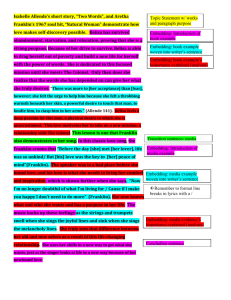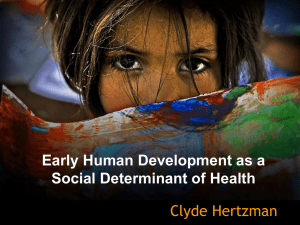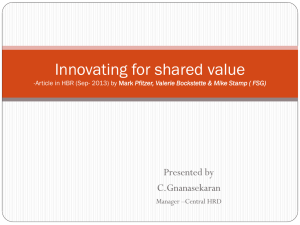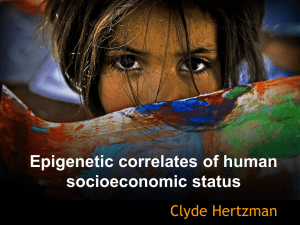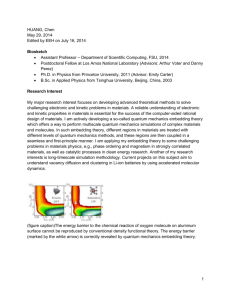Clyde Hertzman, MD Human Early Learning
advertisement
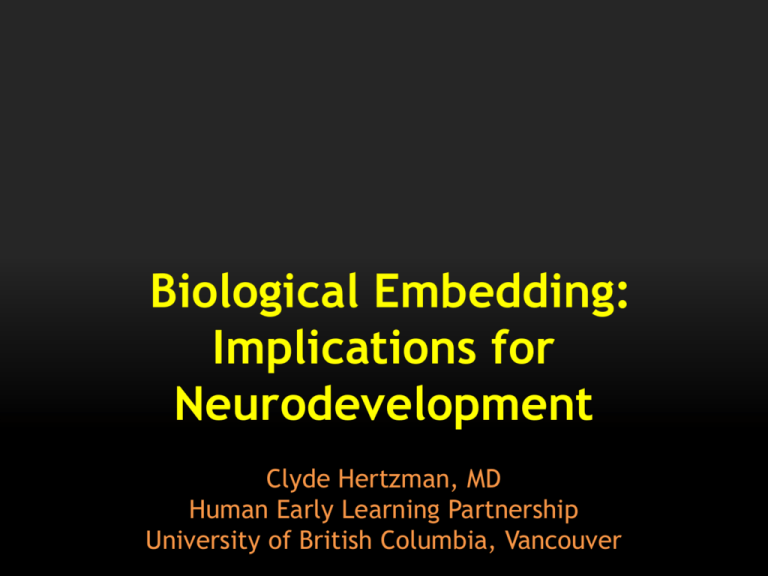
Biological Embedding: Implications for Neurodevelopment Clyde Hertzman, MD Human Early Learning Partnership University of British Columbia, Vancouver Gradient in all Cause Mortality: UK Whitehall Study CHD Mortality - UK Whitehall Study SEP Gradients in Health: Social Determinants to Early Development • ubiquitous in wealthy and majority world countries by income, education, or occupation • cuts across a wide range of disease processes • not explained by traditional risk factors • replicates itself on new conditions as they emerge • occurs among males and females • begins life as gradient in ‘developmental health’ with life course persistence and ‘flattening up’ Percent vulnerable and SES Canada 0 0 31.9 29.1 23.1 0 0 Canada 13.7 very poor poor 31.9 not poor % vulnerable well-off 29.1 23.1 0 13.7 0 0 very poor poor not poor % vulnerable well-off Percent vulnerable and SES 60 Canada 50 Kosovo 56.3 40 43.2 40 30 30.8 20 10 0 60 Australia Q1 Q2 Q3 Q4 % vulnerable Mexico 50 40 35.3 30 27.6 26.3 27.3 24 23.9 20 18.7 17.5 10 16.1 11.2 Bottom 10% 10-25% 25-50% 50-75% % vulnerable 75-90% 0 Top 90% Very poor Poor % vulnerable Not poor Rich Life Course Problems Related to Early Life 2nd Decade • School Failure 3rd/4th Decade • Obesity 5th/6th Decade Old Age • Coronary Heart • Premature Disease Aging • Teen Pregnancy • Elevated Blood Pressure • Diabetes • Criminality • Depression • Memory Loss Biological Embedding Biological embedding occurs when • experience gets under the skin and alters human biodevelopment; • systematic differences in experience in different social environments lead to different biodevelopmental states; • the differences are stable and long-term; they influence health, well-being, learning, and/or behaviour over the life course. Archeology of Biological Embedding Experience/Behavior Neural Circuitry Cell/Synapse Gene Function Surficial Archeology Experience/Behavior (early development in context) Neural Circuitry Cell/Synapse Gene Function Sensitive Periods in Early Brain Development Pre-school years High School years Numbers Peer social skills Symbol Language Habitual ways of responding Emotional control Vision Hearing Low 0 1 2 3 4 Years 5 6 7 Graph developed by Council for Early Child Development (ref: Nash, 1997; Early Years Study, 1999; Shonkoff, 2000.) The Early Development Instrument What Does the EDI Measure? All Children Included in Age 5 School Entry Year ‘Shallow’ Archeology Experience/Behavior Neural Circuitry Cell/Synapse Gene Function Shallow Archeology • HPA axis --- cortisol • ANS system --- epinephrine/ne • Prefrontal cortex • Social affiliation --amygdala/locus cereleus • Immune function -- the ‘peripheral brain’ SES Differences in Prefrontal Cortex Activity by School Age Deep Archeology ‘Social Epigenesis’ and other processes that can influence gene expression Molecular level Start RNA Promoter CH3 Coding sequence Stop plmrs Transcription mRNA Translation protein What’s new about this? It does not only occur during basic fetal development, when cells are specializing……it can continue after birth and be influenced by the broader environment! Biological Embedding: Epigenetic Marks of Early Life Early Life 15-40 yrs 1958 British Birth Cohort Study (Int J Epid, March 2012) 40 adult males selected from SES extremes in both childhood and adulthood • Genome-wide methylation analysis from blood DNA at 45 years of age • 20,000 gene promoter regions • Methylation levels for 1,252 promoters associated with childhood SEP Methylation levels for 1,141 promoters associated with childhood abuse But only approx. 80 promoters associated with maternal smoking during pregnancy! Wisconsin Study of Families and Work Essex, Boyce, Hertzman & Kobor, 2011 Infancy Preschool N = 570 N = 109 Stress: •depression symptoms •expressed anger •parenting stress •role overload •financial stress Epigenetic profiling: •Buccal epithelial cells •Illumina microarray •~28,000 CpG sites in ~14,000 gene promoters Epigenetic vestiges of early developmental adversity • Differential methylation of multiple CpG sites by parental stress in infancy and preschool • Mothers’ stressors in infancy more related to differences in methylation for both girls and boys • Fathers’ stressors in preschool associated with methylation differences primarily for girls • A pattern commensurate with prior knowledge of maternal v paternal and gender-specific influences on development Since 2010, 34 life course studies have included measurements of DNA methylation Ng et al. Genome Biology 2012, (Ng et al, Genoome Biology 2012; 13:246) Journal Articles Referring to Biological Embedding* * Databases searched by M. Wiens -- Ebsco, Google Scholar, PubMed, Scirus, and Web of Knowledge -- August 2012 **2012 includes Jan-July only (part-year) Milestones in Biological Embedding 1 • 2004: Meaney/Szyf paradigm first cited as animal evidence of biological embedding • 2006: first human GxE interaction (childhood maltreatment by MAOA) to be cited as evidence of biological embedding • 2006: biological embedding first used to account for development origins of adult disease • 2006: biological embedding linked to racial health disparities in North America Milestones in Biological Embedding 2 • 2008: biological embedding first used to account for why parents’ social standing is associated with neural development in brains of children • 2008: biological embedding first used to account for the childhood SES/CHD risk relationship • 2008: biological embedding first used to justify investment in the early years as human capital investment • 2010: biological embedding first used to ‘explain’ life course influences of ACE’s Milestones in Biological Embedding 3 • 2010: biological embedding first used as central organizing concept in ‘stress’ study (of inflammation) • 2011: biological embedding first demonstrated in human epigenetics • 2011: biological embedding used to account for SES differences in telomere length • 2012: biological embedding first used to account for validity of allostatic load 2011: Biological Embedding becomes Conventional Wisdom “A scientific consensus is emerging that the origins of adult disease are often found among developmental and biological disruptions occurring during the early years of life. These early experiences can affect adult health in two ways – either by cumulative damage over time or by the biological embedding of adversities during sensitive developmental periods……..” (Leckman JF, March JS. Editorial: Developmental neuroscience comes of age. J Child Psychol Psychiatr. 2011;52(4):333-8.) Merci! www.earlylearning.ubc.ca

